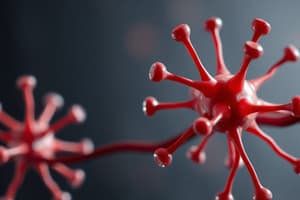Podcast
Questions and Answers
Which drug is primarily indicated for the treatment of orthostatic hypotension?
Which drug is primarily indicated for the treatment of orthostatic hypotension?
- Albuterol
- Clonidine
- Dopamine
- Midodrine (correct)
What is the primary mechanism by which epinephrine causes bronchodilation?
What is the primary mechanism by which epinephrine causes bronchodilation?
- Blocking α1 receptors
- Activating β1 receptors
- Activating β2 receptors (correct)
- Inhibiting cAMP breakdown
Which of the following drugs is most associated with sedation as a common side effect?
Which of the following drugs is most associated with sedation as a common side effect?
- Dobutamine
- Clonidine (correct)
- Albuterol
- Fenoldopam
Which of the following β2 agonists is classified as a long-acting agent?
Which of the following β2 agonists is classified as a long-acting agent?
Which drug acts as a β3 agonist and is used for managing overactive bladder?
Which drug acts as a β3 agonist and is used for managing overactive bladder?
What adverse effect is commonly associated with short-acting β2 agonists?
What adverse effect is commonly associated with short-acting β2 agonists?
In which condition is dopamine primarily used?
In which condition is dopamine primarily used?
What is the role of fenoldopam in medical treatment?
What is the role of fenoldopam in medical treatment?
Which receptor does dobutamine primarily target?
Which receptor does dobutamine primarily target?
Which of the following is NOT a use for epinephrine?
Which of the following is NOT a use for epinephrine?
Which statement about catecholamines is true?
Which statement about catecholamines is true?
What is the primary pharmacological action of phenylephrine?
What is the primary pharmacological action of phenylephrine?
How does tyramine exert its sympathomimetic effect?
How does tyramine exert its sympathomimetic effect?
What is a consequence of combining tyramine with MAO inhibitors?
What is a consequence of combining tyramine with MAO inhibitors?
Which of the following is a noncatecholamine?
Which of the following is a noncatecholamine?
Which adrenergic drug acts as a mixed-action agent?
Which adrenergic drug acts as a mixed-action agent?
Which of the following does NOT describe catecholamines?
Which of the following does NOT describe catecholamines?
What effect does oxymetazoline primarily have?
What effect does oxymetazoline primarily have?
How are catecholamines primarily metabolized?
How are catecholamines primarily metabolized?
What is a characteristic of noncatecholamines compared to catecholamines?
What is a characteristic of noncatecholamines compared to catecholamines?
Flashcards are hidden until you start studying
Study Notes
Adrenergic Drugs: Catecholamines and Noncatecholamines
- Catecholamines include epinephrine, norepinephrine, isoproterenol, dopamine, and dobutamine (synthetic).
- Catecholamines are potent activators of α and β receptors.
- Metabolism is via COMT in the synaptic space and MAO intraneuronally, resulting in a brief effect parenterally and no effect orally.
- Catecholamines are polar and unable to penetrate the CNS.
- Noncatecholamines like phenylephrine, ephedrine, and amphetamine lack the catechol hydroxyl groups and are not inactivated by COMT, leading to longer half-lives.
- Indirect-acting agonists block the reuptake (e.g., cocaine) or cause the release of norepinephrine from the adrenergic neuron (e.g., amphetamine).
- Ephedrine and pseudoephedrine stimulate both α and β receptors directly and enhance norepinephrine release from the adrenergic neuron (mixed action).
- Tyramine, a byproduct of tyrosine metabolism, enters nerve terminals and displaces stored norepinephrine, acting as an indirectly acting sympathomimetic.
- Tyramine levels are elevated in protein-rich foods, especially those undergoing fermentation.
- MAO inhibitors, used as antidepressants, can significantly intensify the sympathomimetic effect of tyramine, leading to high blood pressure.
Direct-Acting Sympathomimetics:
- Oxymetazoline is a direct-acting agonist on both α1 and α2 receptors.
- Phenylephrine is an α1 agonist, not inactivated by COMT, has a longer duration than catecholamines, raises blood pressure, and is used as a nasal decongestant.
- Midodrine is a selective α1 receptor agonist used to treat orthostatic hypotension.
- α2 selective agonists include clonidine, methyldopa, guanfacine, and guanabenz, effective in treating hypertension.
- Clonidine and guanfacine are used for attention deficit disorders.
- These drugs commonly cause sedation, with newer α2 agonists (moxonidine, rilmenidine) having fewer CNS side effects.
Adverse Effects of Nonselective Adrenergic Agonists:
- Epinephrine causes bronchodilation (β2), hyperglycemia (increased glycogenolysis in the liver ( β2), increased glucagon release (β2), decreased insulin (α2)), and lipolysis (increased cAMP and activation of hormone-sensitive lipase in adipose tissue).
- Epinephrine is used for bronchospasm, anaphylactic shock, cardiac arrest, local anesthesia, and intraocular surgery (mydriasis).
Other Adrenergic Agonists:
- Dopamine activates β1 in the heart and dilates renal and splanchnic arterioles through dopamine receptors.
- Uses for dopamine include cardiogenic and septic shock, hypotension, severe heart failure, and bradycardia.
- Fenoldopam is a peripheral D1 receptor agonist used to treat severe hypertension.
- Dobutamine, a synthetic, direct-acting catecholamine, acts as a β1 agonist.
β2 Agonists:
- Short-acting β2 agonists include albuterol, levalbuterol, metaproterenol, and terbutaline, used as bronchodilators, but can cause tremors and should not be used with MAO inhibitors.
- Long-acting β2 agonists include salmeterol, formoterol, arformoterol, and indacaterol, not used as monotherapies.
β3 Agonist:
- Mirabegron, a β3 agonist, relaxes detrusor smooth muscle and increases bladder capacity, used for patients with overactive bladder.
Studying That Suits You
Use AI to generate personalized quizzes and flashcards to suit your learning preferences.




